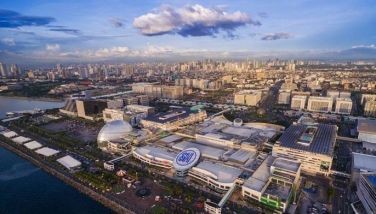Maximum tolerance for rallyists
October 22, 2005 | 12:00am
Cebu City authorities, civilian and police, had a prior agreement to observe maximum tolerance during the anti-Gloria rally yesterday. It was a good decision. As long as the rallyists do their thing in an area that does not obstruct traffic, and as long as they conduct their protests in a peaceful way, they should be left undisturbed to enjoy their right of assembly. But like other rights, this one has its limitations. There's a line between what is a tolerable assembly and a dangerous one. But how is one to know that this line has not been breached? It's really a difficult decision for the ground commander at the rally site.
What happened in the Mendiola rally last week was indeed unfortunate. Perhaps, the senior officer in the area must have misunderstood the government's "calibrated preemptive response". Or had the government failed to brief its police officers on the specifics of this policy? Considering that the right to assemble peaceably for redress of grievances is a Constitutional right, extreme caution on the part of the authorities should be observed. Preemptive response, as far as the average law enforcer is concerned, is a vague and general term, and it is possible that senior police officers do not have a clear idea of what it means. Under what conditions should this response be exercised? The clear and present danger rule has been the usual justification for any action that impairs the right of assembly. But this too has to be clearly defined for law enforcers, otherwise they would resort to take responses (as what happened in Mendiola) that are unjustified.
When a mass of people ventured into an area which was not designated as rally area, did they pose a clear and present danger to the state? Surely, they didn't deserve water canons for doing so. Pressurized water trained on a person throws him off balance and is likely to cause injury. It is a violent measure and, in the case of the Mendiola rally, was therefore uncalled for. And to think that the group was led by a high government official and some religious leaders! Even the presence of a handgun in the possession of one of the rallyists could not justify the government's violent response. Everyone knows one handgun could not pose a danger to the state. Maximum tolerance - this should be the way to treat street demonstrations, except if these get out hand and pose a danger to people's lives.
I remember at the height of martial law in 1982 when a huge rally was conducted in front of the Cebu capitol building for alleged election irregularities. The rallyists, who were led by a number of local politicians, were harangued earlier by the late Salvador Laurel to storm the government building. At that time the provincial canvass committee of which this writer was a member was tallying the election returns in the social hall. The counting having been suspended, we stayed in Governor Gullas' office and from there observed the big mass of angry people in front of the building many of whom were armed with sharpened bamboo poles and stones.
While they were shouting obscenities to the government, a company of PCs were deployed inside the building all armed with long firearms.
Towards late afternoon, the rallyists became more violent.
They entered the front area of the building and set on fire the display boards (containing pictorial exhibits) therein. Then a group of red-turbaned men started working on the front door battering it with stones in an attempt to open it.
"Gob", the PC major who was in the Governor's office asked, "birahan na nato?"
"Ayaw!" the Governor answered. "kalma lang ta!"
And so the demonstrators went on with their fiery, even seditious, speeches until towards sunset perhaps hungry and tired, they dispersed. What would have been a bloody confrontation was avoided because somebody provided the proper guidance to the authorities. If during martial law maximum tolerance was exercised even in moments when the activists went beyond the bounds of the law, how much more these days when Philippine democracy is deemed to have advanced a few steps towards maturity?
PGMA's calibrated preemptive response may be resorted to in exceptional situations such as when violence erupts in the course of a mass action. But even then such measure should be tempered with extreme caution to prevent undue transgression of the right of assembly. Abused, CPR could generate more animosity between the opposition and the government.
What happened in the Mendiola rally last week was indeed unfortunate. Perhaps, the senior officer in the area must have misunderstood the government's "calibrated preemptive response". Or had the government failed to brief its police officers on the specifics of this policy? Considering that the right to assemble peaceably for redress of grievances is a Constitutional right, extreme caution on the part of the authorities should be observed. Preemptive response, as far as the average law enforcer is concerned, is a vague and general term, and it is possible that senior police officers do not have a clear idea of what it means. Under what conditions should this response be exercised? The clear and present danger rule has been the usual justification for any action that impairs the right of assembly. But this too has to be clearly defined for law enforcers, otherwise they would resort to take responses (as what happened in Mendiola) that are unjustified.
When a mass of people ventured into an area which was not designated as rally area, did they pose a clear and present danger to the state? Surely, they didn't deserve water canons for doing so. Pressurized water trained on a person throws him off balance and is likely to cause injury. It is a violent measure and, in the case of the Mendiola rally, was therefore uncalled for. And to think that the group was led by a high government official and some religious leaders! Even the presence of a handgun in the possession of one of the rallyists could not justify the government's violent response. Everyone knows one handgun could not pose a danger to the state. Maximum tolerance - this should be the way to treat street demonstrations, except if these get out hand and pose a danger to people's lives.
I remember at the height of martial law in 1982 when a huge rally was conducted in front of the Cebu capitol building for alleged election irregularities. The rallyists, who were led by a number of local politicians, were harangued earlier by the late Salvador Laurel to storm the government building. At that time the provincial canvass committee of which this writer was a member was tallying the election returns in the social hall. The counting having been suspended, we stayed in Governor Gullas' office and from there observed the big mass of angry people in front of the building many of whom were armed with sharpened bamboo poles and stones.
While they were shouting obscenities to the government, a company of PCs were deployed inside the building all armed with long firearms.
Towards late afternoon, the rallyists became more violent.
They entered the front area of the building and set on fire the display boards (containing pictorial exhibits) therein. Then a group of red-turbaned men started working on the front door battering it with stones in an attempt to open it.
"Gob", the PC major who was in the Governor's office asked, "birahan na nato?"
"Ayaw!" the Governor answered. "kalma lang ta!"
And so the demonstrators went on with their fiery, even seditious, speeches until towards sunset perhaps hungry and tired, they dispersed. What would have been a bloody confrontation was avoided because somebody provided the proper guidance to the authorities. If during martial law maximum tolerance was exercised even in moments when the activists went beyond the bounds of the law, how much more these days when Philippine democracy is deemed to have advanced a few steps towards maturity?
PGMA's calibrated preemptive response may be resorted to in exceptional situations such as when violence erupts in the course of a mass action. But even then such measure should be tempered with extreme caution to prevent undue transgression of the right of assembly. Abused, CPR could generate more animosity between the opposition and the government.
BrandSpace Articles
<
>
- Latest
- Trending
Trending
Latest
Recommended

























